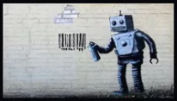
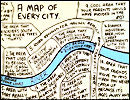 [Illustration from screen print of Prof Justin O'Connor's slide presentation.]The population and development behemoth is so multi-faceted that many of us feel like blind people trying to describe an elephant. Far richer than the bewildering 'policy porn' we are constantly subjected to by planners and growth merchants, the videos from this wonderful symposium provide vital clues to how we have been ambushed and sidelined by the nightmarish infrastructure juggernaut. "The ‘Creative City’ attempts to mobilise culture and creativity for city branding, urban regeneration and cultural industries growth, which also point to new forms of urban planning and governance. It has been closely associated with the “creative class” and the creative- entrepreneurial city in ways that have frequently become divisive and exclusionary, focusing on arts flagships, photogenic CBDs, and real estate profits. So too, cultural production has been reformatted under the rubric of the ‘creative industries’ in ways that foreground their contribution to economic growth. Increasingly calls have been for social justice, citizenship and the rights to the city, with a return of community and activist-focused arts activities, as well as new forms of ‘post-capitalist’ production communities." Source: "Smart City - Creative City", which is where the video of which this article is mostly a transcript, comes from, along with four others. The symposium took place at the Chunky Move – Dance Company Melbourne, Southbank, Australia on 15 June 2017.
[Illustration from screen print of Prof Justin O'Connor's slide presentation.]The population and development behemoth is so multi-faceted that many of us feel like blind people trying to describe an elephant. Far richer than the bewildering 'policy porn' we are constantly subjected to by planners and growth merchants, the videos from this wonderful symposium provide vital clues to how we have been ambushed and sidelined by the nightmarish infrastructure juggernaut. "The ‘Creative City’ attempts to mobilise culture and creativity for city branding, urban regeneration and cultural industries growth, which also point to new forms of urban planning and governance. It has been closely associated with the “creative class” and the creative- entrepreneurial city in ways that have frequently become divisive and exclusionary, focusing on arts flagships, photogenic CBDs, and real estate profits. So too, cultural production has been reformatted under the rubric of the ‘creative industries’ in ways that foreground their contribution to economic growth. Increasingly calls have been for social justice, citizenship and the rights to the city, with a return of community and activist-focused arts activities, as well as new forms of ‘post-capitalist’ production communities." Source: "Smart City - Creative City", which is where the video of which this article is mostly a transcript, comes from, along with four others. The symposium took place at the Chunky Move – Dance Company Melbourne, Southbank, Australia on 15 June 2017.
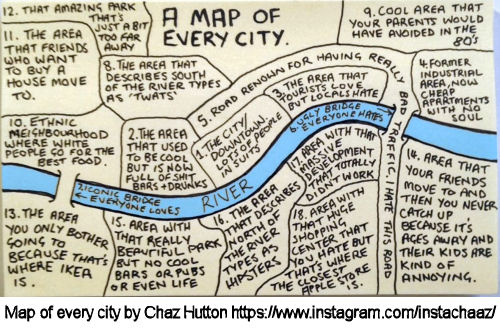
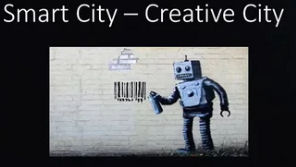
Why the symposium was important
Professor Justin O'Connor, with US Associate Professor Mark Andrejevic hosted a symposium called "Smart City Creative City, whose city is it," at the Chunky Move – Dance Company Melbourne, Southbank, Australia on 15 June 2017. O’Connor is Professor of Communications and Cultural Economy at Monash University and a visiting Professor in the School of Media and Design, Shanghai Jiaotong University. This unusually wide and deep symposium was profoundly helpful to me in understanding, from a new perspective, what has been going on behind the increasing infrastructure sloganeering babble that passes for government policy in Australian cities and elsewhere. There is a global background and history to the current disenfranchisement of citizens and residents from their own environments and properties in favour of giving free reign to midgets dwarfed by gigantic projects made possible by windfalls in global capitalism. This symposium articulates policy vaccuums that should provide bases for proactive rather than reactive citizen and resident demands and participation. Illustrations are taken by screenshot and cropped from O'Connor's slideshow, which you can see in the video. Links to other sites are introduced here by candobetter.net, notably to help explain the importance of certain names cited, such as Robert Moses, Henry Lefevbre and Manuel Castels. All subheadings have been introduced by the editor of candobetter.net.
Disappearance of the smart city - Justin O'Connor introduction to symposium
[Transcript by Sheila Newman]
JUSTIN O'CONNOR: I work in area of creative cites, cultural economy, cultural industries, urban cultural policy, that kind of thing, and Mark Andrevich works in the field of urban media, big data, censors, drones , that kind of thing and, we've been noticing, really over the last two years certainly, the rise, the idea, of the 'smart city'. And we wanted to try and see where these two [the 'smart city' and the 'creative city'] fitted together, or where their two trajectories intersected - or not. But also, there's critics of both of these agendas and we wanted to see what could be possibly retrieved from them. What can - how can we - [?] see a positive agenda both individually and as a kind of joint confluence of two quite powerful agendas.
'Policy porn'
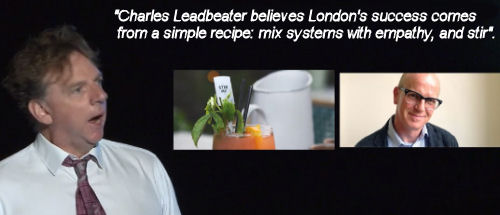
So I'm just going to talk a bit about where I think, really, the creative city idea came from before handing over to Seb and Mark. So, I was looking at this and - you all know what 'gastro-porn' is - well I've decided to start calling this 'policy porn'. This is our man, Charles Leadbeater, who's in Melbourne at the moment [points to slide of Charles Leadbeater quote illustrated here.]
I call it 'policy porn' in the sense it involves models you're never likely to meet in real life. So, London - "London's success comes from a simple recipe: mix systems with empathy and stir." [Indicates amazement.] You know. Has anybody ever been to London? Anyway, I won't go there, but the other aspect of policy porn is, increasingly, it's about - you look, you go to an event, you look at it, looks great, doesn't it, and then nobody actually does anything about it. Which is to say that creative cities is now completely, in many respects, almost a redundant agenda. It has very little traction. It's these kind of silly events, really. And this has been going like this for some time.
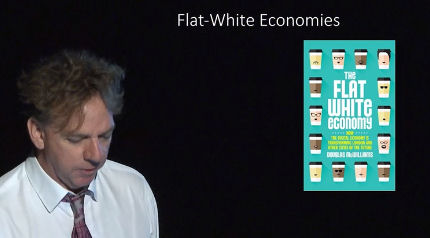
This is a book. I think this is 2014, a particularly bad book, but all about this is now a 'flat white economy'. Lots of 'bright young things' somewhere in Shoreditch drinking flat whites, which, in the UK is seen as a kind of metropolitan set drink, you know. It's a very 'new' kind of thing.
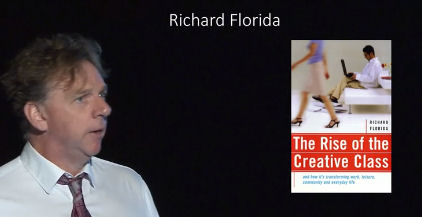
And it goes, obviously futher back, to 2003. This is Richard Florida [refers to overhead with picture of book called Rise of the creative class by Richard Florida.] At least there's statistics in this book. For all the criticisms that it's drawn, at least there's statistics there somewhere.
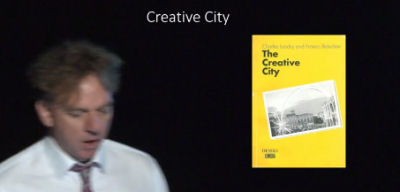
But I wanted to go back to this one, [Indicates slide of book, Creative City by Charles Landry.] Charles Landry's account of the creative city in the mid 1990s, which really came from work that he'd done over the previous decade. And Charles isn't averse to a bit of policy porn himself really, but he, I think, in this book, you know, there's some serious attempts to rethink what the city is. And in this book - it's a very short book - you know, it's the post industrial city, it's about to, it's disappearing as we speak. And what culture does is not, oh, replace - let's have new employment from culture - which, I mean, it's partly in there - but it gives the chance to rethink what the city is.
After a century of top-down, modernist planning - you know, the Robert Moses meat-axe approach to town planning - it's a chance to rethink what it is. And, in three areas, really, it's a kind of wholistic attempt to look at the city. Let's look at the city, including its cultural offer, to rethink what do we mean when we're doing town planning or urban planning or urban vision.
And a lot of it comes back from Jonathan Raban's very seminal Soft City, 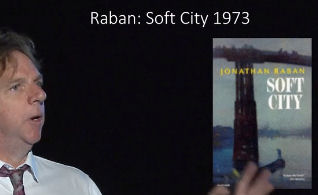 a book from 1973, where he says, you know, 'The city is soft'. It's not this hard city of demographics and statistics. It's actually moulded by the humans who use it. And it's seen as a sort of first step out of that older idea of the industrial city.
a book from 1973, where he says, you know, 'The city is soft'. It's not this hard city of demographics and statistics. It's actually moulded by the humans who use it. And it's seen as a sort of first step out of that older idea of the industrial city.
And Charles Landry is looking back to that and I think it was a real attempt to ask some fundamental questions about the city, before that agenda may be turned somewhere else.

Cultural Consumption: from roots to image capital
One of the things that was very strong, strongly coming out of the creative city agenda was this idea of 'cultural consumption'. [See 'cultural consumption examples' illustration done by candobetter.net editor.] And this is one of the very first ones in '76, I think, it was, in Boston, got this in London, same kind of time, bit later, Fisherman's Wharf. I'll just go through it. Very famously, Albert Dock in Liverpool.
There was this big 'moment' towards post-modernism, and of course, what's been going on here in Melbourne, from the mid-1990s. And, it's easy, as we'll see in a minute, it's easy to see this as a kind of cultural consumption-driven gentrification etcetera, which is one of the large criticisms of this agenda, but, in fact, what it was at its best, was an attempt to rethink the kind of cultural offer of the city. You know, it was a return to some of the 19th century 'city beautiful' movement. Problematic, of course, in themselves, but 'civic pride' to reboot the old opera house-library-theatre cultural infrastructure of the city; to rethink, well, how might we reinvent this infrastructure for a new post-industrial city and a post-industrial population.
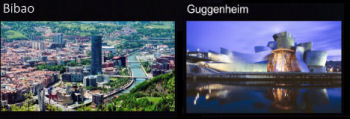
So, I think there was a serious core in that. And, again Bilbao, with the Guggenheim, seen often as a purely kind of top-down consumer driven thing, it actually came out of a deep rethinking of what that city was. And part of [what] the creative city was was an attempt by cities like - where I'm from - Manchester - or Glasgow or Bilbao - cities could say, well, we're not Paris or Venice or, you know, Rome, but we also have a culture and we can also use it to kind of rethink who we are. So I think there's a serious core at it.
[Points to slide of Sage, Gateshead, UK] And this is much later this is 2008, I believe, up in Gateshead, a very deprived area of the UK. And I'll just go through these - [slides of Tate Modern, MONA, West Kowloon, Hong Kong] obvious icons, MONA also, there in Hobart. And this is now, of course, as many of you know now, it's now amped up, souped up, kind of attempts. So we've got West Kowloon in Hong Kong, which is a kind of massive multi-billion-trillion Hong Kong development to kind of give Hong Kong some culture. It's no longer the financial capital of Asia, well let's have some culture there, so we'll knock down the old Kowloon Village and put some of this in. You know, massive real-estate things. UAE's at it, the Emirates are now building really large-scale stuff as - and of course, with lots of problems, as - I've forgotten his name - the American guy writing about the kind of labour involved in building these kind of things. [Slide of Singapore art museum] Singapore of course: "Oh, we're no longer Disneyland with the death penalty, we've got an art gallery." And Shang Hai, which - I won't go into detail - which is this absolutely blatant - they don't bother dressing it up in any kind of artistic language - this is 'image capital' and the use of massive investment and [indistinct].
So, it's come a long way from there, [the serious core referred to] so it's highly problematic, but I wanted to just go back and say, here had some real roots in what rethinking the city was.
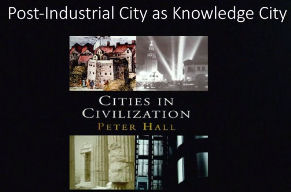
[Slide: Post industrial City as Knowledge City: Peter Hall, Cities in Civilisation]
Knowledge cities and technopolies
And, of course, if we go back to that period, the mid 1990s, the work of Peter Hall comes out, you know, not just of the urban regeneration element that Charles Landry was involved in, but he's been writing with Manuel Castels, he's into the whole idea of technopols, technopolies, he knows about the [indistinct], he's obviously rooted in the planning and architectural world. So he's trying to understand what the post industrial city is by this quite massive kind of reappraisal of what cities have been in history. And he gives the character of cities as 'knowledge', centers of knowledge: You know, we don't just make things now, that's the industrial city. We're 'deal-makers', we're 'ideas-makers', etcetera. Again, at its heart, this was an attempt to rethink what cities do and what they might be.
Cultural productive system and investment in big buildings
Creative city took the cultural productive system end of this; that here in these cities they were producing culture in different ways and - you know, the old idea of the bohemian artist in their quarters - that these were large-scale systems rooted in cities that were producing culture at a new level. And of course, this fed into the cultural creative industries agenda, which often is reduced to this kind of stuff. [Refers to cultural and creative industries slide] 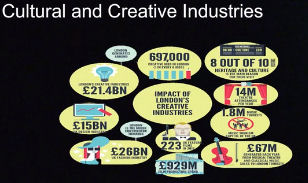 You know, 1.5m, 2.5m, blah, blah, blah, blah, blah, but at its heart, it was about a new kind of economy giving new kinds of livlihoods to people, in a way that was a kind of benign economy. It was networked, it was highly educated, it had 'positive externalities' as the economists say, it's affected the city in good ways. So, it wasn't just, 'Oh, let's get some more jobs and tourism' etcetera. It was about rethinking the cultural economy city as a benign economy. [Slides of Soho, London and of Lower East Side, New York; Northern Quarter, Manchester, UK; Hoxton, London; White Cube, Hoxton; Shorditch; Westergasfabrik, Amsterdam; Kulturbrauerei, Berlin; La Friche, Marseilles; Santral, Istanbul; Witte Dame, Eindhoven; Vinzavod, Moscow; Garage, Moscow; cable Factory, Helsinki, Finland; Collingwood, Melbourne.] And of course we all know how this is fed now. It's a different city from these kind of more organic things. But also now very increasingly investment in big buildings. You know, the revitalisation of the old 19th century infrastructure [refers to above slides] there's a million examples I could have taken. These are just places I have been to. And of course, Moscow, Russia, now of course many of the Asian cities are picking up into these things, which I won't show [referring to slideshow.]
You know, 1.5m, 2.5m, blah, blah, blah, blah, blah, but at its heart, it was about a new kind of economy giving new kinds of livlihoods to people, in a way that was a kind of benign economy. It was networked, it was highly educated, it had 'positive externalities' as the economists say, it's affected the city in good ways. So, it wasn't just, 'Oh, let's get some more jobs and tourism' etcetera. It was about rethinking the cultural economy city as a benign economy. [Slides of Soho, London and of Lower East Side, New York; Northern Quarter, Manchester, UK; Hoxton, London; White Cube, Hoxton; Shorditch; Westergasfabrik, Amsterdam; Kulturbrauerei, Berlin; La Friche, Marseilles; Santral, Istanbul; Witte Dame, Eindhoven; Vinzavod, Moscow; Garage, Moscow; cable Factory, Helsinki, Finland; Collingwood, Melbourne.] And of course we all know how this is fed now. It's a different city from these kind of more organic things. But also now very increasingly investment in big buildings. You know, the revitalisation of the old 19th century infrastructure [refers to above slides] there's a million examples I could have taken. These are just places I have been to. And of course, Moscow, Russia, now of course many of the Asian cities are picking up into these things, which I won't show [referring to slideshow.]
Not comfortable places at all
So, we've got this huge investment in kind of spaces and around cultural production that's really kind of transforming the city. 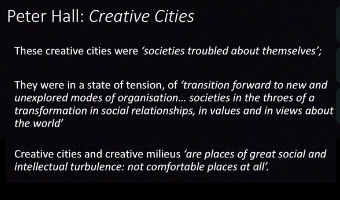 And it's really just - again - coming back to that original thinking, or original kind of moment, and thinking, you know, what exactly is a creative city? And I think this will be picked up a bit by certain others [means other speakers] as we go through, that - and Peter Hall says, when asked it - this is not in his book, this was an article written after his book came out - you know, what is the creative city? And he said, [that] 'These creative cities are societies troubled about themselves, they're in a state of tension', "of transition forward to new and unexplored modes of organisation ... societies in the throes of a tranformation in social relationships, in values and in views about the world." [Citing from slide.] And, of course, that means they 'are places of great social and intellectual turbulence. They're not comfortable places at all'.
And it's really just - again - coming back to that original thinking, or original kind of moment, and thinking, you know, what exactly is a creative city? And I think this will be picked up a bit by certain others [means other speakers] as we go through, that - and Peter Hall says, when asked it - this is not in his book, this was an article written after his book came out - you know, what is the creative city? And he said, [that] 'These creative cities are societies troubled about themselves, they're in a state of tension', "of transition forward to new and unexplored modes of organisation ... societies in the throes of a tranformation in social relationships, in values and in views about the world." [Citing from slide.] And, of course, that means they 'are places of great social and intellectual turbulence. They're not comfortable places at all'.
Now, let's flick you back to Charles Leadbeater: You can have it all! you know, you can just add recipes and mix and shake and you'll get a great city. It's not too bad, in fact, just leave it to us - (Aside: And I think, and I'll leave some of those ideas to the people talking more about smart cities) - and, this is somehow - we're going to transform ourselves; we don't really have to do anything, except buy an iphone perhaps. And I think he's just trying to understand then, what is at stake now, because, that, to me, describes us now.
We're certainly not in a comfortable place, we're certainly in social turbulence. Intellectual turbulence? I'm not sure. I think that's something we have to start doing, because at the moment, in many respects, we're in a space of intellectual quiescence; intellectual kind of dumbing down, in many respects - certainly in the area of public policy. [Slide citing Ezra Pound]
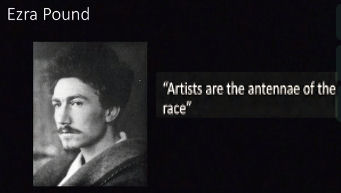
Questions artists ask
So, the idea, 'Artists are the antennae of the race': this is the classic statement of the avant-guarde - early 19th century, 20th century avant-guarde. But, what we're talking about here is what artists thought they were doing in looking forward. [Aside: adverts to other speakers] But what they're looking forward at is not just rule-breaking or innovating in art, it's about trying to understand what is happening around them. And I think that key role for culture in understanding what are these spaces of turbulence; how are we moving from one set of values to another; how do we explain the crisis we are in; is something that cultural policy, in part, is about, needs to do. That's what it's often been about.
Important questions reduced to econometrics
And my concern at the moment, certainly from the creative cities point of view, is that there is none of those questions being asked within cultural policy at the moment. These questions are reduced, usually, to econometrics. You know, the main task of cultural policy is to show what economic impact it has for other departments. And there's no other department - health, education - there's no other department that's asked to express its main value through how it hits on somebody else's agenda. The question of cultural value, what culture does, how it should fit within the city, or how it adds to the city, these questions are not being asked on its own terms.
[Slide 'Collective Sensorium': Towards an Aesthetic of Performative Defiance: Autonomy and Weltbezug by Sebastian Olma] We talked about artists as the antennae of the race. This is Seb's book, which I've put up there [referring to slide] because he paid me to [jokingly]. Collective sensorium: This is a part of what culture is. How do we use our senses collectively to understand the crisis through which we're going, and I think these are some things we need to ask.
We need to make demands of the policy-makers
So, here we are, in the time of the creative city, in the time of the smart city, and yet some fundamental questions about what the city is for are barely being asked, certainly at the level of policy and urban planning. They are all on the periphery of that, but they are not being asked properly. And I think it's something that we need to demand of our policy-makers; that these are now big agendas that come with large budgets, they come with large visions; they have the ability to define what a city is and how we work within it, and yet, as I say, those deeper questions, some fundamental questions that were being asked in the mid 90s are no longer being asked.
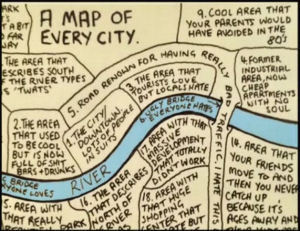
Melbourne will become more uncomfortable; we must avoid being stuck with 'changeless change'.
So, without getting too Henri Lefebvre on you, the city is to be built, we're now at an uncomfortable place - less so in Melbourne than in other places, but it will come - we're in an uncomfortable place of transition and, unless we find ways to understand how we're going to move forward, we're going to be stuck with 'changeless change'.

Add comment